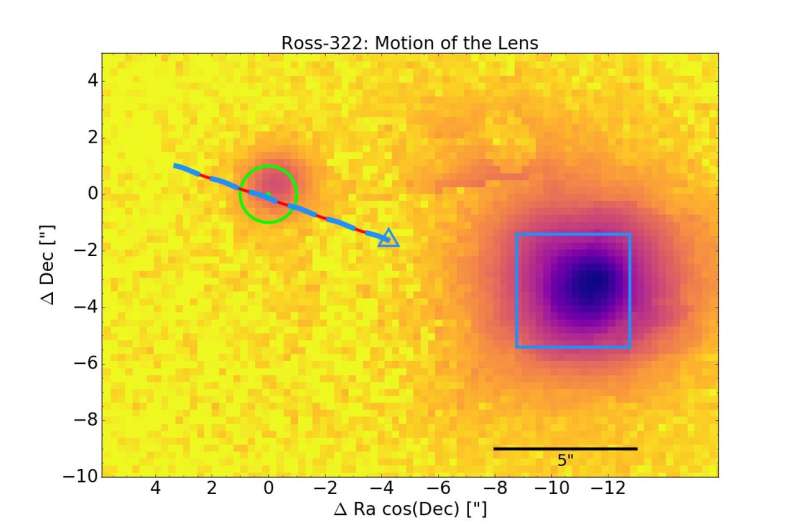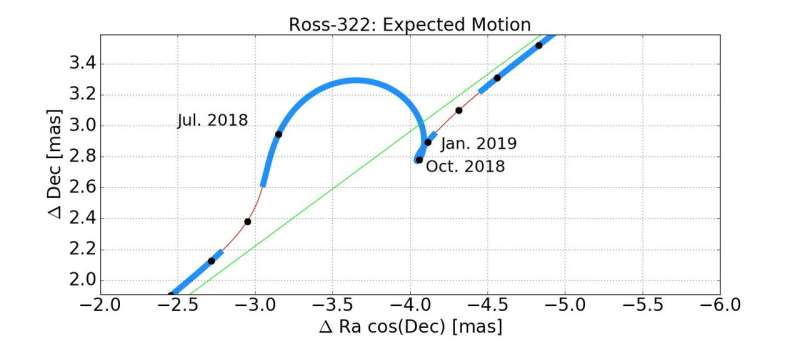Image from the PAN-STARRS Telescope at Hawaii from early 2011 with the foreground star Ross 322 (blue square) and the background star (at the centre of the green circle) which will be traversed by Ross 322 in the next few weeks. By summer 2015, Ross 322 had moved to the position of the blue triangle (measured by Gaia). Since then, it has been moving along the blue-red line and is currently close to the position of the background star. Credit: Astronomy & Astrophysics
Astronomy & Astrophysics publishes the predictions of the passages of foreground stars in front of background stars. A team of astronomers, using ultra-precise measurements from the Gaia satellite, have accurately forecast two passages in the next months. Each event will produce shifts in the background star's position due to the deflection of light by gravity, and will allow the measurement of the mass of the foreground star, which is extremely difficult to determine by other means.
Every star in the Milky Way is in motion. But because of the distances their changes in position, the so-called proper motions, are very small and can only be measured using large telescopes over long time periods. In very rare cases, a foreground star passes a star in the background, at close proximity as seen from Earth. Light from this background star must cross the gravitational field of the foreground star where, instead of following straight paths, the light rays are bent. This is like a lens, except here the deviation is caused by the space and time distortion around any massive body. This effect was one of the cornerstone predictions of Einstein's general theory of relativity and has been verified in solar system tests for decades. This distortion of the light by the foreground star is called gravitational lensing: the light of the background star is deviated or focused into a smaller angle, and the star appears brighter. The main effect is the change in the star's apparent position on the sky because the deviation shifts the centre of light relative to other more distant stars. Both of these effects depend on only one thing, the mass of the lensing body, in this case that of the foreground star. Thus, gravitational lensing is a method for weighing stars. Actually, measuring the mass of stars that are not part of a binary star is otherwise extremely difficult to do.
Previously, the difficulty in this method was being able to predict the motions of the stars with high enough precision. The spectacular data set of literally billions of stellar positions and proper motions recently published as the Gaia Data Release 2 by the ESA Gaia consortium has made this research possible. These data were used by Jonas Klüter, who is doing a Ph.D. at Heidelberg University, to search for such close passages of stars. Of the many close encounters which will happen in the next 50 years, two passages are going on right now: the closest angular separations will be reached in the next few weeks with measurable effects on the positions of the background stars. The names of these two foreground stars are Luyten 143-23 and Ross 322; they move across the sky with apparent velocities of about 1,600 and 1,400 milliarcseconds per year, respectively. The closest angular separations between foreground and background stars will occur in July and August 2018, respectively, when the apparent positions of the background stars will be shifted, due to the astrometric microlensing effect, by 1.7 and 0.8 milliarcseconds. One milliarcsecond corresponds to the angle under which a human being lying on the surface of the moon would be seen. It is a challenging task, but with the best telescopes on Earth, these displacements of stellar positions are measurable.
When Ross 322 passes the background star, its expected track (thin green line) will be affected and modified by gravitational lensing. The characteristic positional changes produced by the gravitational lens effect are shown as a thick blue-thin red line; the black dots mark certain dates. The largest shift between the actual position (blue-red line) and the unperturbed position (green line) is expected in early August 2018. Credit: Astronomy & Astrophysics
More information: J. Klüter et al, Ongoing astrometric microlensing events of two nearby stars, Astronomy & Astrophysics (2018). DOI: 10.1051/0004-6361/201833461
Journal information: Astronomy & Astrophysics
Provided by Astronomy & Astrophysics

























